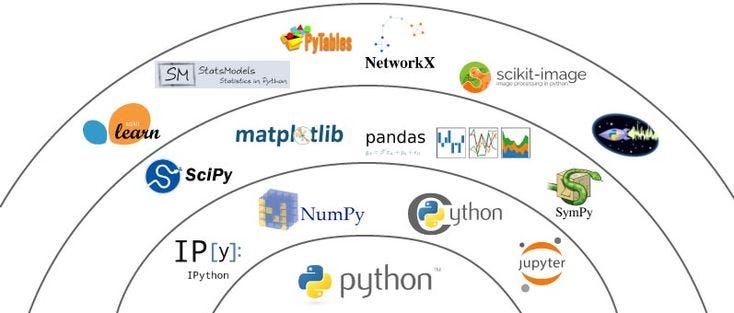🚀 Python Libraries Powering the AI & ML Revolution in 2025! 🧠✨
🚀 Python Libraries Powering the AI & ML Revolution in 2025! 🧠✨
Artificial Intelligence (AI) and Machine Learning (ML) have moved from buzzwords to real-world game changers. From ChatGPT and DALL·E to predictive healthcare and fraud detection, Python is the silent hero behind most innovations. Why? Because of its powerful libraries! 📚💡
In this blog, we’ll explore the top Python libraries that are shaping the future of AI & ML — with examples, key features, and their best use cases. Let’s dive in! 🏊♂️👇

1. 🔮 TensorFlow — Google’s Brainchild
“The library that made deep learning practical.”
🔧 Features:
- Developed by Google Brain team
- Supports deep learning, neural networks, and custom ML models
- Works seamlessly on CPUs, GPUs, and TPUs
- Integrates with Keras for high-level APIs
📌 Example:
import tensorflow as tf
model = tf.keras.Sequential([
tf.keras.layers.Dense(128, activation='relu'),
tf.keras.layers.Dense(10)
])✅ Best Use Case:
- Building deep neural networks, image recognition, NLP, and production-level AI systems
2. 🧠 PyTorch — Favored by Researchers
“If TensorFlow is Google, PyTorch is Facebook.”
🔧 Features:
- Developed by Facebook AI Research
- Easy debugging with dynamic computation graphs
- Hugely popular in research and academic communities
- Seamless integration with Pythonic code
📌 Example:
import torch
import torch.nn as nn
model = nn.Sequential(
nn.Linear(10, 5),
nn.ReLU(),
nn.Linear(5, 1)
)✅ Best Use Case:
- Prototyping AI models, academic research, and NLP models like BERT
3. 🧮 Scikit-learn — ML Made Simple
“The classic and clean ML library for everyone.”
🔧 Features:
- Built on NumPy, SciPy, and matplotlib
- Offers tools for classification, regression, clustering, and more
- Great for preprocessing and model evaluation
📌 Example:
from sklearn.ensemble import RandomForestClassifier
clf = RandomForestClassifier()
clf.fit(X_train, y_train)✅ Best Use Case:
- Quick ML model building, exploratory data analysis, and teaching
4. 📊 Pandas — Data’s Best Friend
“Without clean data, there’s no smart model.”
🔧 Features:
- Easy-to-use data structures: DataFrames & Series
- Tools for reading/writing data, handling missing values, and filtering
- Essential for data wrangling
📌 Example:
import pandas as pd
df = pd.read_csv("data.csv")
df = df.dropna()✅ Best Use Case:
- Data preprocessing, exploratory analysis, and feature engineering
5. 📈 NumPy — Math Under the Hood
“The backbone of all scientific computing in Python.”
🔧 Features:
- Provides multi-dimensional arrays
- Offers mathematical functions for linear algebra, Fourier transforms, and more
- Extremely fast due to underlying C implementation
📌 Example:
import numpy as np
a = np.array([1, 2, 3])
b = np.array([4, 5, 6])
result = a + b✅ Best Use Case:
- All AI/ML libraries use it internally. Great for numerical operations and matrix manipulations
6. 🧰 Keras — Simplicity for Deep Learning
“Beginner-friendly wrapper over TensorFlow.”
🔧 Features:
- Modular and easy to use
- Quickly prototype deep learning models
- Now integrated into TensorFlow as
tf.keras
📌 Example:
from tensorflow.keras.models import Sequential
from tensorflow.keras.layers import Dense
model = Sequential([
Dense(64, activation='relu'),
Dense(1)
])✅ Best Use Case:
- Rapid prototyping of deep learning architectures for beginners and pros alike
7. 🧬 OpenCV — Vision to Your Code
“Making machines see the world like we do.”
🔧 Features:
- Real-time computer vision library
- Image and video processing, face detection, object tracking
- Cross-platform support
📌 Example:
import cv2
img = cv2.imread('image.jpg')
gray = cv2.cvtColor(img, cv2.COLOR_BGR2GRAY)✅ Best Use Case:
- Face recognition, autonomous driving, surveillance, and image processing
8. 💬 NLTK & spaCy — NLP Game-Changers
“Words are the new data — and these libraries read them best!”
🔧 Features:
- NLTK: Best for research and teaching NLP
- spaCy: Best for production NLP apps (fast and efficient)
- Tokenization, POS tagging, named entity recognition (NER), etc.
📌 Example (spaCy):
import spacy
nlp = spacy.load("en_core_web_sm")
doc = nlp("Apple is looking at buying U.K. startup.")
for entity in doc.ents:
print(entity.text, entity.label_)✅ Best Use Case:
- Text mining, chatbots, sentiment analysis, NLP pipelines
9. 📉 XGBoost — The Competition Killer
“The go-to library for winning ML competitions.”
🔧 Features:
- Fast and efficient implementation of gradient boosting
- Handles missing data
- Regularization to avoid overfitting
📌 Example:
import xgboost as xgb
model = xgb.XGBClassifier()
model.fit(X_train, y_train)✅ Best Use Case:
- Tabular data, Kaggle competitions, and financial forecasting
10. 🧪 Hugging Face Transformers — NLP on Steroids
“One library to rule all transformer-based models!”
🔧 Features:
- Pre-trained models like BERT, GPT, T5, RoBERTa
- Easy integration with PyTorch & TensorFlow
- Huge model hub with APIs
📌 Example:
from transformers import pipeline
qa = pipeline("question-answering")
result = qa(question="What is AI?", context="AI stands for Artificial Intelligence.")
print(result)✅ Best Use Case:
- Chatbots, summarization, translation, and question-answering AI
⚡ Final Thoughts
Python isn’t just a programming language — it’s a powerhouse behind today’s AI & ML breakthroughs. 🚀 Whether you’re a beginner or a pro, these libraries are your toolkit to build the future.
🔁 Which library is your favorite?
💬 Comment below or share with your AI buddies!
Comments
Post a Comment